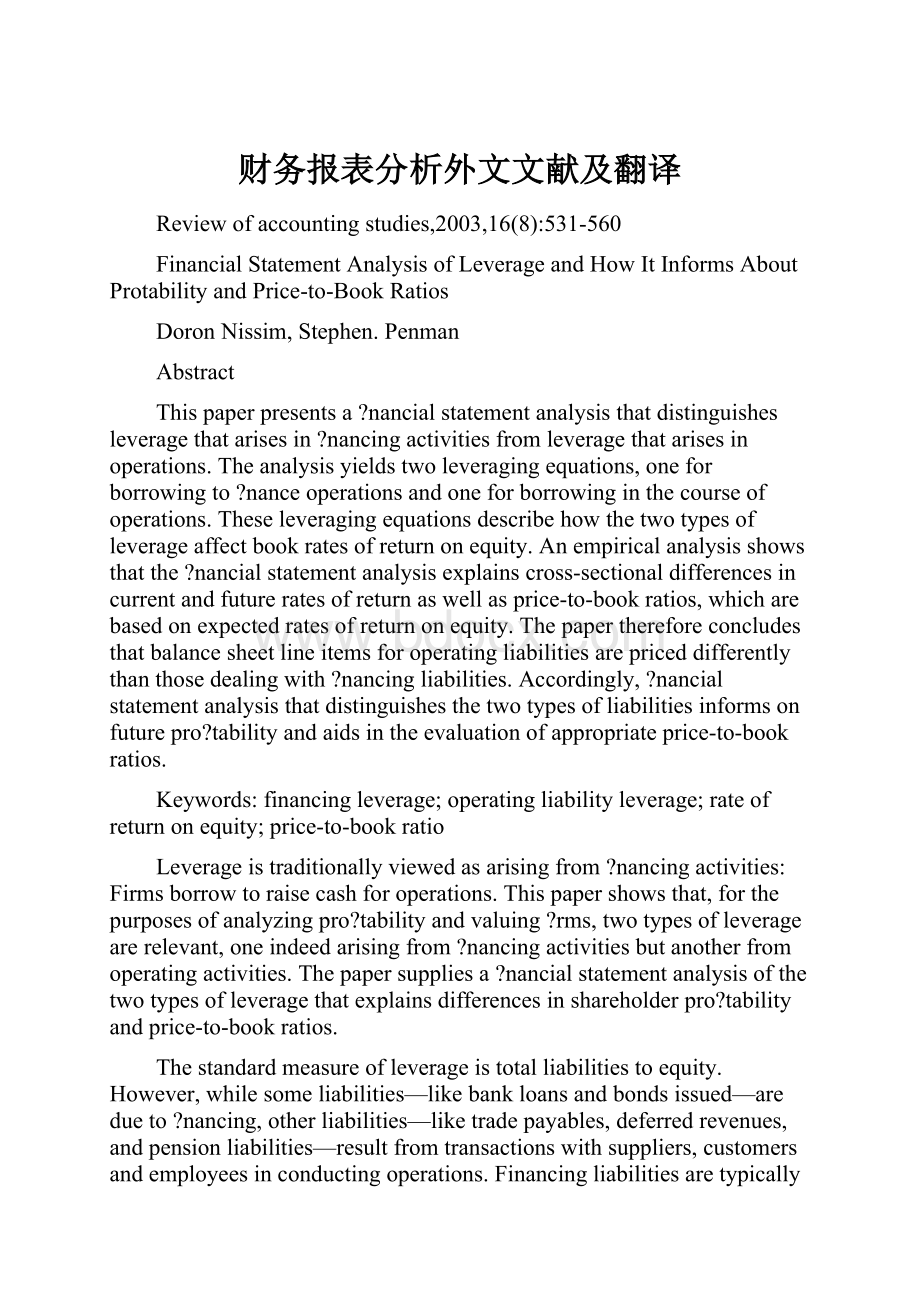财务报表分析外文文献及翻译.docx
《财务报表分析外文文献及翻译.docx》由会员分享,可在线阅读,更多相关《财务报表分析外文文献及翻译.docx(22页珍藏版)》请在冰豆网上搜索。

财务报表分析外文文献及翻译
Reviewofaccountingstudies,2003,16(8):
531-560
FinancialStatementAnalysisofLeverageandHowItInformsAboutProtabilityandPrice-to-BookRatios
DoronNissim,Stephen.Penman
Abstract
Thispaperpresentsa?
nancialstatementanalysisthatdistinguishesleveragethatarisesin?
nancingactivitiesfromleveragethatarisesinoperations.Theanalysisyieldstwoleveragingequations,oneforborrowingto?
nanceoperationsandoneforborrowinginthecourseofoperations.Theseleveragingequationsdescribehowthetwotypesofleverageaffectbookratesofreturnonequity.Anempiricalanalysisshowsthatthe?
nancialstatementanalysisexplainscross-sectionaldifferencesincurrentandfutureratesofreturnaswellasprice-to-bookratios,whicharebasedonexpectedratesofreturnonequity.Thepaperthereforeconcludesthatbalancesheetlineitemsforoperatingliabilitiesarepriceddifferentlythanthosedealingwith?
nancingliabilities.Accordingly,?
nancialstatementanalysisthatdistinguishesthetwotypesofliabilitiesinformsonfuturepro?
tabilityandaidsintheevaluationofappropriateprice-to-bookratios.
Keywords:
financingleverage;operatingliabilityleverage;rateofreturnonequity;price-to-bookratio
Leverageistraditionallyviewedasarisingfrom?
nancingactivities:
Firmsborrowtoraisecashforoperations.Thispapershowsthat,forthepurposesofanalyzingpro?
tabilityandvaluing?
rms,twotypesofleveragearerelevant,oneindeedarisingfrom?
nancingactivitiesbutanotherfromoperatingactivities.Thepapersuppliesa?
nancialstatementanalysisofthetwotypesofleveragethatexplainsdifferencesinshareholderpro?
tabilityandprice-to-bookratios.
Thestandardmeasureofleverageistotalliabilitiestoequity.However,whilesomeliabilities—likebankloansandbondsissued—aredueto?
nancing,otherliabilities—liketradepayables,deferredrevenues,andpensionliabilities—resultfromtransactionswithsuppliers,customersandemployeesinconductingoperations.Financingliabilitiesaretypicallytradedinwell-functioningcapitalmarketswhereissuersarepricetakers.Incontrast,?
rmsareabletoaddvalueinoperationsbecauseoperationsinvolvetradingininputandoutputmarketsthatarelessperfectthancapitalmarkets.So,withequityvaluationinmind,thereareapriorireasonsforviewingoperatingliabilitiesdifferentlyfromliabilitiesthatarisein?
nancing.
Ourresearchaskswhetheradollarofoperatingliabilitiesonthebalancesheetispriceddifferentlyfromadollarof?
nancingliabilities.Asoperatingand?
nancingliabilitiesarecomponentsofthebookvalueofequity,thequestionisequivalenttoaskingwhetherprice-to-bookratiosdependonthecompositionofbookvalues.Theprice-to-bookratioisdeterminedbytheexpectedrateofreturnonthebookvalueso,ifcomponentsofbookvaluecommanddifferentpricepremiums,theymustimplydifferentexpectedratesofreturnonbookvalue.Accordingly,thepaperalsoinvestigateswhetherthetwotypesofliabilitiesareassociatedwithdifferencesinfuturebookratesofreturn.
Standard?
nancialstatementanalysisdistinguishesshareholderpro?
tabilitythatarisesfromoperationsfromthatwhicharisesfromborrowingto?
nanceoperations.So,returnonassetsisdistinguishedfromreturnonequity,withthedifferenceattributedtoleverage.However,inthestandardanalysis,operatingliabilitiesarenotdistinguishedfrom?
nancingliabilities.Therefore,todevelopthespeci?
cationsfortheempiricalanalysis,thepaperpresentsa?
nancialstatementanalysisthatidenti?
estheeffectsofoperatingand?
nancingliabilitiesonratesofreturnonbookvalue—andsoonprice-to-bookratios—withexplicitleveragingequationsthatexplainwhenleveragefromeachtypeofliabilityisfavorableorunfavorable.
Theempiricalresultsinthepapershowthat?
nancialstatementanalysisthatdistinguishesleverageinoperationsfromleveragein?
nancingalsodistinguishesdifferencesincontemporaneousandfuturepro?
tabilityamong?
rms.Leveragefromoperatingliabilitiestypicallyleverspro?
tabilitymorethan?
nancingleverageandhasahigherfrequencyoffavorable,foragiventotalleveragefrombothsources,?
rmswithhigherleveragefromoperationshavehigherprice-to-bookratios,onaverage.Additionally,distinctionbetweencontractualandestimatedoperatingliabilitiesexplainsfurtherdifferencesin?
rms’pro?
tabilityandtheirprice-to-bookratios.
Ourresultsareofconsequencetoananalystwhowishestoforecastearningsandbookratesofreturntovalue?
rms.Thoseforecasts—andvaluationsderivedfromthem—depend,weshow,onthecompositionofliabilities.The?
nancialstatementanalysisofthepaper,supportedbytheempiricalresults,showshowtoexploitinformationinthebalancesheetforforecastingandvaluation.
Thepaperproceedsasfollows.Section1outlinesthe?
nancialstatementsanalysisthatidenti?
esthetwotypesofleverageandlaysoutexpressionsthattieleveragemeasurestopro?
tability.Section2linksleveragetoequityvalueandprice-to-bookratios.TheempiricalanalysisisinSection3,withconclusionssummarizedinSection4.
1.FinancialStatementAnalysisofLeverage
Thefollowing?
nancialstatementanalysisseparatestheeffectsof?
nancingliabilitiesandoperatingliabilitiesonthepro?
tabilityofshareholders’equity.Theanalysisyieldsexplicitleveragingequationsfromwhichthespeci?
cationsfortheempiricalanalysisaredeveloped.Shareholderpro?
tability,returnoncommonequity,ismeasuredas
Returnoncommonequity(ROCE)=comprehensivenetincome÷commonequity
(1)
Leverageaffectsboththenumeratoranddenominatorofthispro?
tabilitymeasure.Appropriate?
nancialstatementanalysisdisentanglestheeffectsofleverage.Theanalysisbelow,whichelaboratesonpartsofNissimandPenman(2001),beginsbyidentifyingcomponentsofthebalancesheetandincomestatementthatinvolveoperatingand?
nancingactivities.Thepro?
tabilityduetoeachactivityisthencalculatedandtwotypesofleverageareintroducedtoexplainbothoperatingand?
nancingpro?
tabilityandoverallshareholderpro?
tability.
DistinguishingtheProtabilityofOperationsfromtheProtabilityofFinancingActivities
Withafocusoncommonequity(sothatpreferredequityisviewedasa?
nancialliability),thebalancesheetequationcanberestatedasfollows:
Commonequity=operatingassets+financialassets-operatingliabilities-Financialliabilities
(2)Thedistinctionherebetweenoperatingassets(liketradereceivables,inventoryandproperty,plantandequipment)and?
nancialassets(thedepositsandmarketablesecuritiesthatabsorbexcesscash)ismadeinothercontexts.However,ontheliabilityside,?
nancingliabilitiesarealsodistinguishedherefromoperatingliabilities.Ratherthantreatingallliabilitiesas?
nancingdebt,onlyliabilitiesthatraisecashforoperations—likebankloans,short-termcommercialpaperandbonds—areclassi?
edassuch.Otherliabilities—suchasaccountspayable,accruedexpenses,deferredrevenue,restructuringliabilitiesandpensionliabilities—arisefromoperations.Thedistinctionisnotassimpleascurrentversuslong-termliabilities;pensionliabilities,forexample,areusuallylong-term,andshort-termborrowingisacurrentliability.
Rearrangingtermsinequation
(2),
Commonequity=(operatingassets-operatingliabilities)-(financialliabilities-financialassets)
Or,
Commonequity=netoperatingassets-netfinancingdebt(3)
Thisequationregroupsassetsandliabilitiesintooperatingand?
nancingactivities.Netoperatingassetsareoperatingassetslessoperatingliabilities.Soa?
rmmightinvestininventories,buttotheextenttowhichthesuppliersofthoseinventoriesgrantcredit,thenetinvestmentininventoriesisreduced.Firmspaywages,buttotheextenttowhichthepaymentofwagesisdeferredinpensionliabilities,thenetinvestmentrequiredtorunthebusinessisreduced.Net?
nancingdebtis?
nancingdebt(includingpreferredstock)minus?
nancialassets.So,a?
rmmayissuebondstoraisecashforoperationsbutmayalsobuybondswithexcesscashfromoperations.Itsnetindebtednessisitsnetpositioninbonds.Indeeda?
rmmaybeanetcreditor(withmore?
nancialassetsthan?
nancialliabilities)ratherthananetdebtor.
Theincomestatementcanbereformulatedtodistinguishincomethatcomesfromoperatingand?
nancingactivities:
Comprehensivenetincome=operatingincome-netfinancingexpense(4)
Operatingincomeisproducedinoperationsandnet?
nancialexpenseisincurredinthe?
nancingofoperations.Interestincomeon?
nancialassetsisnettedagainstinterestexpenseon?
nancialliabilities(includingpreferreddividends)innet?
nancialexpense.Ifinterestincomeisgreaterthaninterestexpense,?
nancingactivitiesproducenet?
nancialincomeratherthannet?
nancialexpense.Bothoperatingincomeandnet?
nancialexpense(orincome)areafterEquations(3)and(4)producecleanmeasuresofafter-taxoperatingpro?
tabilityandtheborrowingrate:
Returnonnetoperatingassets(RNOA)=operatingincome÷netoperatingassets(5)
and
Netborrowingrate(NBR)=netfinancingexpense÷netfinancingdebt(6)
RNOArecognizesthatpro?
tabilitymustbebasedonthenetassetsinvestedinoperations.So?
rmscanincreasetheiroperatingpro?
tabilitybyconvincingsuppliers,inthecourseofbusiness,tograntorextendcreditterms;creditreducestheinvestmentthatshareholderswouldotherwisehavetoputinthebusiness.Correspondingly,thenetborrowingrate,byexcludingnon-interestbearingliabilitiesfromthedenominator,givestheappropriateborrowingrateforthe?
nancingactivities.